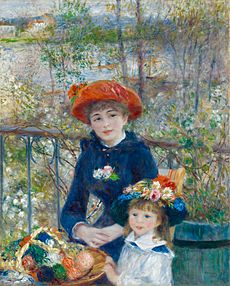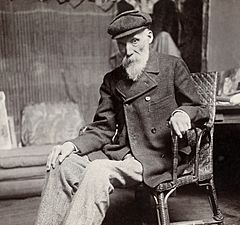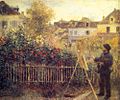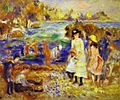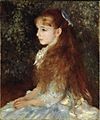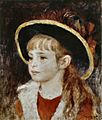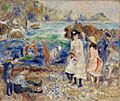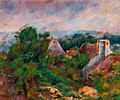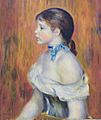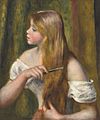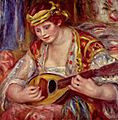Pierre-Auguste Renoir facts for kids
Quick facts for kids
Pierre-Auguste Renoir
|
|
|---|---|
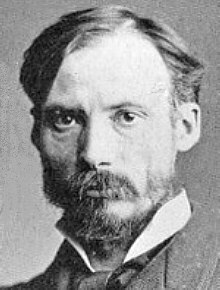 |
|
| Nationality | French |
| Known for | Painting |
| Movement | Impressionism |
Pierre-Auguste Renoir (25 February 1841–3 December 1919) was a French artist. He was a leading painter who helped to create the Impressionist style. He painted portraits, and still life, but above all, he painted social scenes of the day.
As a painter of women, it has been said that "Renoir is the final representative of a tradition which runs directly from Rubens to Watteau".
Youth
Pierre-Auguste Renoir was born in Limoges, Haute-Vienne, France, the child of a working class family. As a boy, he worked in a porcelain factory where his drawing talents led to him being chosen to paint designs on fine china. He also painted hangings for overseas missionaries and decorations on fans before he enrolled in art school. During those early years, he often visited the Louvre to study the French master painters.
Maturity
In the late 1860s, through the practice of painting light and water en plein air (in the open air), he and his friend Claude Monet discovered that the color of shadows is not brown or black, but the reflected color of the objects surrounding them, an effect today known as diffuse reflection. Several pairs of paintings exist in which Renoir and Monet, working side-by-side, depicted the same scenes (La Grenouillère, 1869).
Renoir experienced his initial acclaim when six of his paintings hung in the first Impressionist exhibition in 1874. In the same year, two of his works were shown with Paul Durand-Ruel in London.
One of the best known Impressionist works is Renoir's 1876 Dance at Le Moulin de la Galette (Bal du moulin de la Galette). The painting depicts an open-air scene, crowded with people, at a popular dance garden on the Butte Montmartre, close to where he lived. The works of his early maturity were typically Impressionist snapshots of real life, full of sparkling colour and light.
A trip to Italy in 1881, when he saw works by Raphael and other Renaissance masters, convinced him that he was on the wrong path. For the next several years he painted in a more severe, classical, style. After 1890, however, he changed direction again, returning to thinly brushed colour to dissolve outlines as in his earlier work. From this period onward he concentrated on nudes and domestic scenes.
A prolific artist, he made several thousand paintings. The warm sensuality of Renoir's style made his paintings some of the most well-known and reproduced works in the history of art. The single largest collection of his works—181 paintings in all—is at the Barnes Foundation, near Philadelphia, Pennsylvania.
In 1890, he married Aline Victorine Charigot. She, with a number of the artist's friends, had been a model for Le Déjeuner des canotiers (Luncheon of the Boating Party, 1881). They already had a child, Pierre, in 1885. After his marriage, Renoir painted many scenes of his wife and daily family life, including their children and their nurse, Aline's cousin. The Renoirs had three sons, one of whom, Jean, became a film director of note and another, Pierre, became a stage and film actor.
Old age

Around 1892, Renoir developed rheumatoid arthritis. In 1907, he moved to the warmer climate of "Les Collettes," a farm at Cagnes-sur-Mer, close to the Mediterranean coast. Renoir painted during the last twenty years of his life, even when arthritis severely limited his movement, and he was wheelchair-bound. He developed progressive deformities in his hands and ankylosis of his right shoulder, requiring him to adapt his painting technique. It has often been reported that in the advanced stages of his arthritis, he painted by having a brush strapped to his paralyzed fingers, but this is erroneous; Renoir remained able to grasp a brush, although he required an assistant to place it in his hand. The wrapping of his hands with bandages, apparent in late photographs of the artist, served to prevent skin irritation.
During this period, he created sculptures by cooperating with a young artist, Richard Guino, who worked the clay. Renoir also used a moving canvas, or picture roll, to help him paint large works.
In 1919, Renoir visited the Louvre to see his paintings hanging with the old masters. He died in the village of Cagnes-sur-Mer, Provence-Alpes-Côte d'Azur, on 3 December.
Artworks
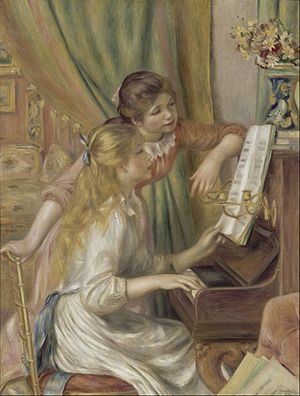
Renoir's paintings are notable for their vibrant light and saturated color.
His initial paintings show the influence of the colorism of Eugène Delacroix and the luminosity of Camille Corot. He also admired the realism of Gustave Courbet and Édouard Manet, and his early work resembles theirs in his use of black as a color. Renoir admired Edgar Degas' sense of movement. Other painters Renoir greatly admired were the 18th-century masters François Boucher and Jean-Honoré Fragonard.
Renoir's style made his paintings some of the most well-known and frequently reproduced works in the history of art. The single largest collection of his works—181 paintings in all—is at the Barnes Foundation, in Philadelphia.
Gallery
-
Bal au moulin de la Galette (Montmatre) 1876
-
The Theater Box, 1874, Courtauld Institute Galleries, London
-
The Swing (La Balançoire), 1876, oil on canvas, Musée d'Orsay, Paris
-
Girls at the Piano, 1892, Musée d'Orsay, Paris
-
Portrait of Alphonsine Fournaise, 1879, Musée d'Orsay, Paris, France
-
Portrait of Alfred Sisley, 1868
-
Claude Monet Painting in His Garden at Argenteuil, 1873, Wadsworth Atheneum, Hartford, Connecticut
-
Portrait of Claude Monet, 1875, Musée d'Orsay, Paris, France
-
A Girl with a Watering Can, 1876, National Gallery of Art, Washington, D.C.
-
Mme. Charpentier and her children, 1878, Metropolitan Museum of Art, New York
-
Portrait of Alphonsine Fournaise, 1879, Musée d'Orsay, Paris, France]]
-
By the Water, 1880, Art Institute of Chicago, Chicago, Illinois
-
Luncheon of the Boating Party, 1880–1881, The Phillips Collection, Washington, D.C.
-
Dance at Bougival, 1882–1883, (woman at left is painter Suzanne Valadon), Boston Museum of Fine Arts
-
Dance in the Country (Aline Charigot and Paul Lhote), 1883, Musée d'Orsay, Paris
-
Pencil study for Dance in the Country, 1883, Honolulu Museum of Art
-
Children at the Beach at Guernsey, 1883, Barnes Foundation, Philadelphia
-
Girl With a Hoop, 1885, National Gallery of Art, Washington, D.C.
-
Still Life: Flowers, 1885, Solomon R. Guggenheim Museum, New York
-
Portrait of Berthe Morisot and daughter Julie Manet, 1894
-
Gabrielle Renard and infant son Jean Renoir, 1895
-
Portrait of Ambroise Vollard, 1908
-
Portrait of Paul Durand-Ruel, 1910
-
Portrait of Ambroise Vollard, 1917
-
Self-portrait, 1875
-
Self-portrait, 1876
-
Self-portrait, 1910
Images for kids
-
Two Sisters (On the Terrace), oil on canvas, 1881, Art Institute of Chicago
-
La Parisienne, 1874, (Henriette Henriot), National Museum Cardiff
-
Mother and Children, 1876, Frick Collection, New York City
-
Sleeping Girl with a Cat, Clark Art Institute, Williamstown, Massachusetts
-
Pink and Blue showing Alice and Elisabeth Cahen d'Anvers, 1881, São Paulo Museum of Art, São Paulo
-
Dance at Bougival, 1882–1883, (woman at left is painter Suzanne Valadon), Boston Museum of Fine Arts
-
Dance in the City, 1883, Musée d'Orsay, Paris, France
-
Children at the Beach at Guernsey, 1883, Barnes Foundation, Philadelphia
-
La Roche Guyon, 1885–86, Aberdeen Art Gallery
-
Portrait of Berthe Morisot and daughter Julie Manet, 1894
-
Head of a Young Woman, late 19th century (Minneapolis Institute of Art)
-
Woman with a Mandolin, 1919
See also
 In Spanish: Pierre-Auguste Renoir para niños
In Spanish: Pierre-Auguste Renoir para niños



